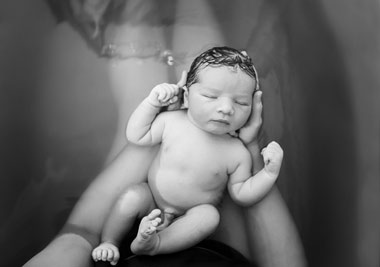What is water birth?
During water immersion in labour, women get into a tub or pool of warm water during the first stage of labour, before the baby is born. In a water birth, the mother remains in the water during the pushing phase and actual birth of the baby. The baby is then brought to the surface of the water after it is born. A water birth may be followed by the birth of the placenta in or out of the water.
Incidence
The incidence is very low in this country as not many hospitals or birth centers in Malaysia provide this type of service. To date, it is not provided in the hospitals of the ministry of health.

Source : http://www.midwiferytoday.com/articles/graphics/LeilaniRogers_115cover.jpg
Advantages
It seems the use of warm water immersion during labour promotes a sense of relaxation and buoyancy for some women, who then find that the pain of labour is more tolerable, thus making them able to use less pharmacological analgesia (e.g. epidurals and narcotics). Other possible advantages include:
- Lower rates of episiotomy,
- Higher rates of intact perineum,
- Possibly lower rates of 3rd or 4th degree tears,
- Possibly lower rates of postpartum hemorrhage,
- Possibly fewer NICU admissions after water birth (it is not known whether the lower NICU admission rates are due to water birth itself or because women are asked to leave the tub for the birth at the slightest hint of problems with the fetal heart rate)
Disadvantages
There is a higher rate of 1st and 2nd degree perineal tears in water birth, but that is because women in the water may have natural tears instead of episiotomies. Other complications include:
- Umbilical cord snap is a rare but possible occurrence.
- There have been several case reports of water aspiration (most babies made a complete recovery).
- Possible increase in the risk of infection, especially form unclean hospital water supply, hoses, and tubs or no installing of water filters.
Which mothers are eligible for water birth?
Those eligible include:
- Healthy women with an uncomplicated pregnancy at term,
- a singleton pregnancy;
- no other risk factors or problems during labour;
- preferably have clear liquor;
- Have no other requirement for continuous electronic fetal monitoring (EFM) during labour. (Continuous EFM can be done by telemetry, allowing women warm water immersion, but this is not always available in all centers).
Which mothers are NOT eligible for water birth?
These include:
- The inability of the center to provide hot, clean tap water;
- the mother who needs other pharmacological analgesic agents;
- maternal exhaustion;
- Mother having poor progress in labour.
- Medical conditions of the mother e.g. Hypertension, Obesity, Gestational Diabetes mellitus
- Babies condition: large babies, breeches, twins pregnancy, meconium (indicate a stressed baby).
- Ruptured membrane prematurely.
Very few centers in Malaysia have water birth facilities. Many of their staff are also not trained in conducting water birth. It is advisable that the patient and her spouse discuss with their obstetricians on the options and availability of such service.
At this moment, the Director of Health, has banned all water births in any health facilities in Malaysia until the National Guidelines on water births is ready and the facilities who are keen to provide this services fullfills all the criteria to ensure patient safety.
References
- http://evidencebasedbirth.com/waterbirth/
- http://www.rcht.nhs.uk/DocumentsLibrary/RoyalCornwallHospitalsTrust/Clinical/MidwiferyAndObstetrics/WaterDuringLabourAndBirthClinicalGuidelineForTheUseOf.pdf
- The Cochrane database, immersion in water in labour and birth
- The American College of Obstetricians and Gynecologist, committee opinion , immersion in water during labor and delivery
- The royal college of midwives UK, immersion in water birth
- The Royal College of Obstetricians and Gynecologist UK: immersion water during labour and birth
| Last Reviewed | : | 23 August 2019 |
| Writer | : | Dr. Hj. Mohamed Hatta b. Mohamed Tarmizi |
| Accreditor | : | Dr. Haris Njoo Suharjono |
| Reviewer | : | Dr. Rafaie bin Amin |







